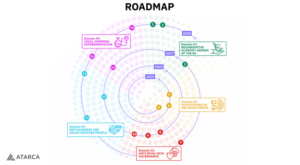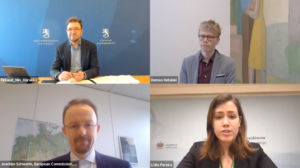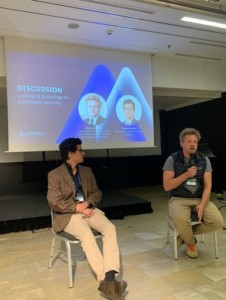Humans are social animals, fundamentally drawn to community. We are born with a desire to connect with others, form relationships, and be part of a group. Today, this same desire for community is evident in the way people join clubs, participate in groups, and form online communities. Being part of a community provides individuals with a sense of belonging, identity, and purpose. In addition, communities can serve as powerful platforms for social change and personal growth of each individual member.
If you are building a web3 community, it is important to understand and tap into this fundamental human desire for connection. Creating a sense of belonging, identity, and purpose in your community will help attract members and keep them engaged in the community over time. But how do you go about building a strong and vibrant community in the web3 space?
Audience “does not equal” community
The terms “audience” and “community” are often used interchangeably, but there is quite a difference between them. While an audience simply consumes information or content, a community is made up of active, contributing members who are self-organizing. To build a strong web3 community, it is important to focus on building a group of active, contributing members rather than simply trying to attract a large audience. Encourage members to take an active role in the community by creating opportunities for them to participate and contribute. This will help create a sense of ownership and investment in the community’s success – people will feel like they have “a skin in the game”, and will make the community more resilient, responsive, and more effective.
The Advantages of Having a Strong Community
By building a strong community, you can rely on word-of-mouth and organic growth to attract new members. This can significantly lower your marketing costs, as you won’t have to spend as much on paid advertising for expanding the community or promoting your project. A strong community can also help you lower your customer acquisition costs. Community members can act as brand ambassadors that attract new customers and users to your project.
By engaging with your community and actively soliciting feedback, you can create demand for your project or product and get early insight into what users want. A strong community can also provide you with new networking and connection opportunities. You can connect with other like-minded individuals and projects in the industry, which can help you expand your reach and gain new insights.
A dedicated community can also provide you with support during tough times, such as a bear market. Community members can act as a sounding board and offer emotional and marketing support, which can help you when going through difficult periods.
Composability – Use Mutual Strengths on Three Levels
Composability is critical for every web3 project as it allows projects to highlight each other’s strengths and lift each other up on the way to adoption. Composability can happen on three levels:
- Smart Contract Composability: This is the ability to link and use together multiple smart contracts to create more complex and powerful decentralized applications.
- Project Composability: This is the ability for different blockchain projects to work together and integrate their technology to create a stronger ecosystem.
- Community Composability: This is the ability for different groups and individuals within the blockchain community to collaborate and build on each other’s work to drive innovation and adoption of the technology.
By focusing on composability within the community, you can create opportunities for collaboration and growth that will drive the overall success and adoption of your project.
Staying Up-to-Date with Web3 Development
Another thing which is important: Stay informed about recent web3 developments. You should keep track of new projects, technologies, and trends in the web3 ecosystem. This will help you identify new opportunities for collaboration and growth within your community.
Transparency is Key
Transparency is the foundation of any thriving community. Be transparent about your plans, share information about your project, including its goals, development progress, and any challenges or obstacles you are facing. Communicate transparently by sharing information about your project and its development in a timely and clear manner. Encourage community engagement by asking for feedback and ideas.
Be accountable: Take responsibility for your actions and decisions, and be willing to explain and justify them to the community. Trust is built on transparency, and a transparent community is a healthy and thriving community.
Involving the Community in Key Decisions via Voting
One of the best ways to involve the community in decision-making is through voting. However, the voting process can be complex and time-consuming. Not all community members may have the same level of knowledge or expertise, and there is a very high risk of voter apathy or low voter turnout.
To overcome these issues, it’s important to ensure that the voting process is straightforward and transparent. Community members should have access to clear information about the issue at hand, and the voting system should be easy to use.
Create a Project Roadmap
A roadmap is a crucial tool for any web3 project. It should emphasize the long-term vision of the project and include specific milestones that demonstrate progress towards this vision. It should also focus on community involvement, highlighting ways for the community to get involved through governance or development.
The roadmap should show a clear path to adoption, demonstrating real-world use cases. Be transparent about the progress of the project and any challenges that may arise. Being open upfront about setbacks and challenges ahead helps to build trust and shows that the project is being managed responsibly.
Consider the entire ecosystem
As you build your project, you should keep in mind who is part of your ecosystem, what motivates them, and how you can tap into those motivations. Web3 projects often rely heavily on the contributions and participation of the wider community and not just a handful of developers. One way to improve your understanding of your ecosystem and these motivations is to use the Anti-rival business design tool-kit. You can access the tool-kit and a free course on how to use the tool-kit (modeled on the Streamr community!) here.
Community Membership Gamification
Gamification is a great way to encourage engagement and participation within a community. Leaderboards, badges, and rewards (both monetary and non-monetary) are some of the popular gamification techniques.
Non-monetary rewards can be especially effective. They grant users a sense of recognition, social value, or proof of skill. These rewards can also be used to grant user access to a private sub-community or chat.
Shareable NFTs
Recently, the Ethereum community has introduced a new type of NFT: the shareable NFT. The concept is based on a recently published Ethereum Request for Comment – ERC-5023. These NFTs can be used to grow online communities by providing recognition that is decentralized and shareable.
Shareable NFTs could also provide a stronger “sense of belonging” for community members. We have developed a dapp, hosted at talkoapp.io, to facilitate these NFTs at different stages.
Regular NFT vs Shareable NFT
Regular NFTs are typically transferrable, whereas shareable NFTs are not. However, shareable NFTs can be shared with other wallets, granting a sense of recognition and a stronger sense of belonging within the community.
If you’re looking to enhance the engagement of your community and make it more interactive, shareable NFTs can be a great way to do it. They offer a unique way to reward your community members and create a connection with your brand.
If you’re interested in creating your own shareable NFTs, feel free to reach out to us at info@talkoapp.io. Our team can help you deploy the smart contracts and guide you through the entire process of minting your sNFTs.
With shareable NFTs, the possibilities are endless. So don’t wait, get in touch with us today.
—-
Building a thriving web3 community takes time and effort. If you want to try out the Talko platform for yourself, take our free and open online course, An introduction to anti-rivalry, and earn your own sNFT right away. Learn what anti-rivalry means for business and community management, and receive an anti-rival expert token straight to your wallet. Access the course (and get your token!) at https://atarca.eu/courses/mooc/












 In terms of the draft recommendations presented, Davila noted the importance of local, bottom-up DLT experimentation through cooperatives. The European Union should continue to be more cautious regarding big platforms within the DLT and blockchain context as well, as they have been with the Digital Markets Act. For Kaevats, governance architectures are needed to improve the scalability of DLT solutions. One provocative solution would be to tokenize everything, down to people’s shoe sizes, as a way to lessen bureaucracy and enable more seamless services. For Davila, there’s a danger to this: tokenization and commodification of everything on the market would have adverse social effects. Moreover, having everything on the chain increases the chance of cryptographic surveillance and discriminatory profiling.
In terms of the draft recommendations presented, Davila noted the importance of local, bottom-up DLT experimentation through cooperatives. The European Union should continue to be more cautious regarding big platforms within the DLT and blockchain context as well, as they have been with the Digital Markets Act. For Kaevats, governance architectures are needed to improve the scalability of DLT solutions. One provocative solution would be to tokenize everything, down to people’s shoe sizes, as a way to lessen bureaucracy and enable more seamless services. For Davila, there’s a danger to this: tokenization and commodification of everything on the market would have adverse social effects. Moreover, having everything on the chain increases the chance of cryptographic surveillance and discriminatory profiling.
